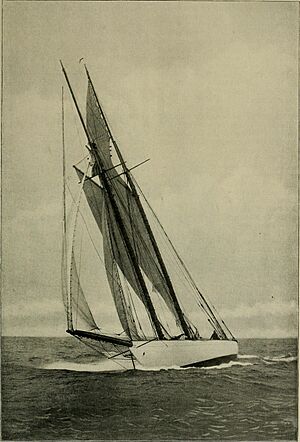Fore-and-aft rig facts for kids
A fore-and-aft rig is a special way to set up the sails on a sailing boat. Instead of the sails going across the boat (like a square rig), they run along the length of the boat, from front to back (fore-and-aft). This design helps boats move well in different wind conditions. When a boat has sails set up this way, we say it is fore-and-aft rigged.
History of Fore-and-Aft Rigs
Some of the first boats to use fore-and-aft sails were the Chinese junk and the lateen sails found on Egyptian Feluccas and dhows. The lateen sail, which is shaped like a triangle, was used by Greek ships as early as the 9th century.
By the 11th century, this type of rig started to appear in the Italian city-states and around the Mediterranean Sea. The calm weather there made it easy to use these sails.
In Northern Europe, the Vikings and others first used square-rigged sails, which go across the boat. These were very popular in Britain and Northern Europe. People in the North likely saw fore-and-aft rigs during trade and the Crusades.
Later, during the Renaissance, the fore-and-aft rig slowly became more common. It was especially useful on rivers and in estuaries (where rivers meet the sea) in Great Britain, Northern France, and the Low Countries. For the rougher waters of the North Sea and long trips across the Atlantic Ocean, the square rig remained the main choice.
The lateen sail was easier to steer and faster in some conditions. Square rigs were strong and good for long journeys, even if they felt a bit clumsy.
Related Sailing Topics
Images for kids
-
The gaff-rigged schooner Effie M. Morrissey
-
The earliest European fore-and-aft rigs appeared in the form of spritsails in Greco-Roman navigation, as this carving of a 3rd century AD Roman merchant ship
See also
 In Spanish: Aparejo proa-popa para niños
In Spanish: Aparejo proa-popa para niños






